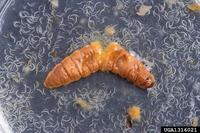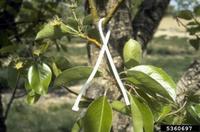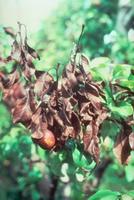|
June 18, 2009
Source: ENDURE, the European
Network for the Durable Exploitation of Crop Protection
Strategies
http://www.endure-network.eu/about_endure/all_the_news/easing_the_way_for_biological_controls
 For
a pest control technique that is currently enjoying strong
growth, biological control of pests has a long history. In fact,
as far back as the late 1800s it proved a success when citrus
growers in California, USA, introduced a predatory insect, the
vedalia beetle, and a parasitoid fly from Australia to control
Icerya purchasi, the cottony cushion scale, that was devastating
their crops. For
a pest control technique that is currently enjoying strong
growth, biological control of pests has a long history. In fact,
as far back as the late 1800s it proved a success when citrus
growers in California, USA, introduced a predatory insect, the
vedalia beetle, and a parasitoid fly from Australia to control
Icerya purchasi, the cottony cushion scale, that was devastating
their crops.
Similarly, the International
Organisation for Biological and Integrated Control of Noxious
Animals and Plants (IOBC) was first formed in 1952.
Currently, the use of biologicals is growing at around 15% per
year, and to ensure that healthy situation is maintained, and
maybe improved still further, ENDURE representatives will be
meeting with the European Commission in September to discuss the
place of biologicals in the ‘pesticides package’ regulations.
 A
key member of that ENDURE
team will be Bernard Blum, head of international affairs
at ENDURE partner IBMA (International
Biocontrol Manufacturers Association) and a member of the
Académie
d’Agriculture de France (French Society of Agriculture).
Bernard will be part of a team meeting representatives from the
Commission’s departments of agriculture, health, environment and
enterprise and research, and ahead of the event we spoke to him
to find out more. A
key member of that ENDURE
team will be Bernard Blum, head of international affairs
at ENDURE partner IBMA (International
Biocontrol Manufacturers Association) and a member of the
Académie
d’Agriculture de France (French Society of Agriculture).
Bernard will be part of a team meeting representatives from the
Commission’s departments of agriculture, health, environment and
enterprise and research, and ahead of the event we spoke to him
to find out more.
QUESTION: How can biological controls contribute to IPM
(integrated pest management) strategies? Can you provide some
concrete examples?
BERNARD BLUM: In technical terms, IPM is the coordinated
use of pest and environmental information with available pest
control methods to prevent unacceptable levels of pest damage by
the most economical means and with the least possible hazard to
people, property, and the environment. The IPM approach can be
applied to both agricultural and non-agricultural settings, such
as the home, garden and woodland recreation areas and so forth,
and takes advantage of all appropriate pest management options
including, but not limited to, the judicious use of pesticides.
In the past, farmers were used to using together and according
to their needs, all kinds of available techniques. However, the
discovery of synthetic chemical pesticides - very cheap and
effective against pests, diseases and weeds - let us think that
they would, alone, solve all the protection problems. In reality
their excessive use led to heavy environmental and health
problems, and the development of resistance etc, making it
necessary to return to more sensible combined protection
concepts.
| |
 |
|
This
wax moth cadaver contains thousands of nematodes which
serve as a biocontrol against soil-dwelling crop pests.
Copyright: Peggy Greb, USDA Agricultural Research
Service, Bugwood.org. |
In the meantime, research has been
actively working on alternative biological systems. The new
biological solutions proved to be extremely selective, usually
environmentally friendly and safer for the users and the public.
In reality, biological controls, contrary to chemical
pesticides, are not so much targeting the destruction of the
pests but rather aimed at guarding the health of the crops and
the quality of the production.
Biological control is using the mode of action of four classes
of ‘products’: micro-organisms (viruses, bacteria or fungi),
macro-organisms (benefical insects and nematodes),
semiochemicals (insect pheromones and bioactive molecules) and
natural extracts (botanicals etc) They can be introduced in
cropping areas in order to protect the plant or, in conservation
biocontrol, in order to enable the existing beneficial
population to protect naturally the crops.
In the concept of IPM, each product, including chemicals, is
used according to economical thresholds, at a given time,
related to its mode of action, its risks and benefits. Due to
their ecological and health benefits, biologicals are the
methods of choice for IPM.
In order to provide the expected result, they need nevertheless
to be used at the right time and under strict conditions. For
example, entomopathogen nematodes are extremely effective
against soil pests. But they need to be introduced at the exact
time when the target insects come close to the surface in soil
that is wet enough (irrigated) in order to ensure their
mobility.
| |
 |
|
Pheromone dispensers such as this one can disrupt the
mating process of insect pests. Copyright: Eugene E
Nelson, Bugwood.org. |
In IPM, biologicals do not exclude
the use of chemical pesticides. The chemical pesticides need to
be selective enough in order to not endanger the biologicals, or
used in such conditions that they are not acting against them.
Such a concept is well illustrated with the use of insect
pheromones. These products can be used either in order to
confuse the males, making it impossible for them to mate, or
attracting them in traps. The use of insect pheromones is
totally compatible with the use of fungicides, herbicides, even
all kinds of insecticides and acaricides.
Another example is the use of antagonist bacteria, such as
Bacillus subtilis which will colonise the entry sites of
Erwinia, the bacteria responsible for fireblight in pomefruits
(apples and pears). In that case it is, naturally, inadvisable
to use any fungicides, but herbicides or insecticides can be
used without problem.
QUESTION: What does the pesticides package mean for the
use of biocontrols?
BERNARD BLUM: Due to the benefits I have just described,
non-chemical plant protection measures and particularly
biologicals are especially promoted in both the new Regulation
for the placing of pesticides on the market and the Framework
Directive for the sustainable use of pesticides. The EU
Commission as well as the Parliament intend to promote the use
of biologicals, which are the easiest way of reducing the use of
chemical pesticides and therefore the risks attached to plant
protection.
In order to promote the use of biologicals, it is foreseen that
funding will be required for specific research, information and
training will need to be developed, and subsidies may even be
provided to farmers starting to use biologicals. The French
plan, ECOPHYTO 2018, has a target of reducing pesticide use by
50% by the year 2018, and says alternative biological systems
should be actively promoted.
Due to these policies and regulations, the use of biological
controls is growing at the rate of 15% per year, not so much in
organic farming but for IPM programmes. It is anticipated that
25-30% of the crops in Europe will adopt the use of biologicals
in IPM by 2030.
QUESTION: How could the legislation be changed to
encourage the use of biocontrols?
| |
 |
|
Antagonist bacteria can be used to control diseases such
as fireblight, seen here. Copyright: Michel Ride, INRA,
France. |
BERNARD BLUM: Despite what
I have said, the regulations remain a major handicap for the
development of biologicals due to the fact that these
regulations have been developed with chemical pesticides in
mind. They are therefore unnecessarily complicated, costly and
time consuming.
During the five years from 2004 until 2008, the European Union
funded an important project, REBECA, in order to provide
scientific bases for new regulations adapted to biologicals.
Unfortunately the project came too late in order to be taken in
consideration within the pesticides package which was due to be
adopted by the EU parliament at the end of 2008.
ENDURE therefore took up the challenge to come up with adapted
regulations. The first step has been to summarise the gaps,
problems and opportunities resulting from the pesticides package
and enter into a dialogue in order to suggest adaptations. Due
to the nature of biologicals (mainly living organisms) and their
mode of action, it is very important to have very specific
regulations adapted to each class of biological.
The safety studies should specifically better address the real
risk of the considered agent and the concept of efficacy adapted
to purpose of using biologicals. For example, it looks
nonsensical to evaluate the number of insects killed by using
insect pheromones which are not intended to kill any.
Essentially, the evaluation of the registration dossier must be
made by biocontrol experts rather than by toxicologists, as is
done for chemical pesticides. Additionally, it is the case that
biocontrol is and will remain extremely specific. Biologicals
will never be applied to large, voluminous markets. Therefore
the costs of registration should not be detrimental to their
commercial development.
Finally, since we are looking at a situation where biological
controls need to be developed and promoted within a very short
period of time, the registration process should be reduced to a
strict minimum. |
|